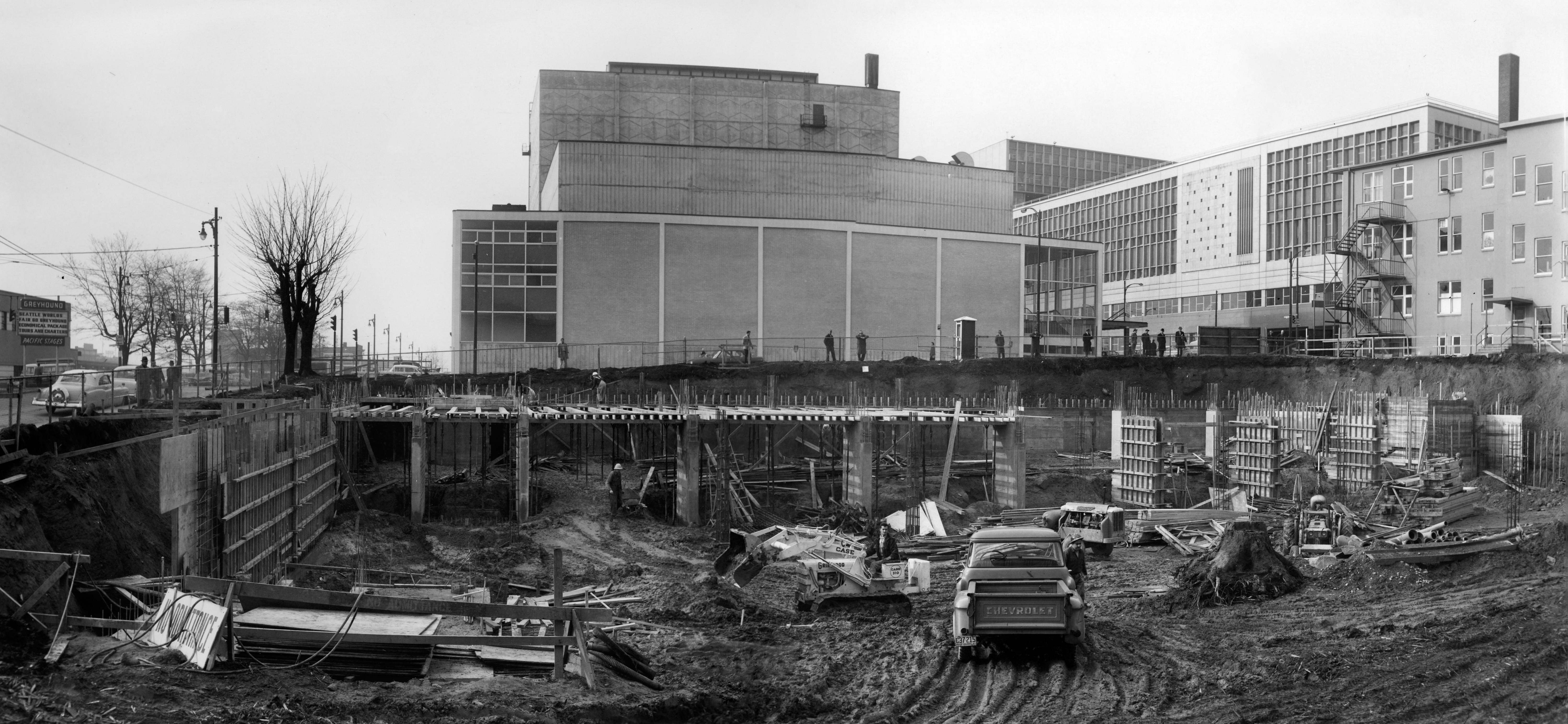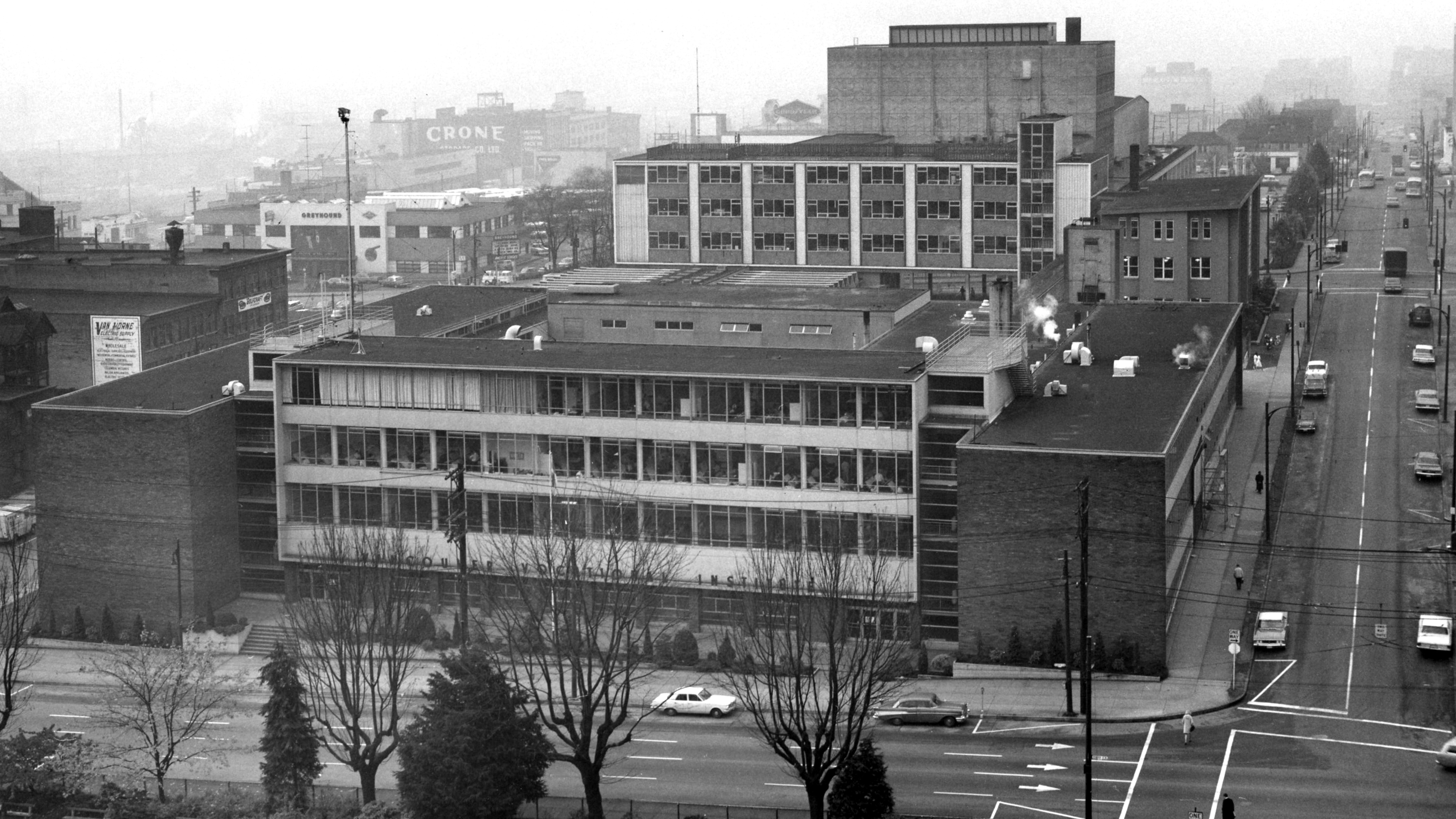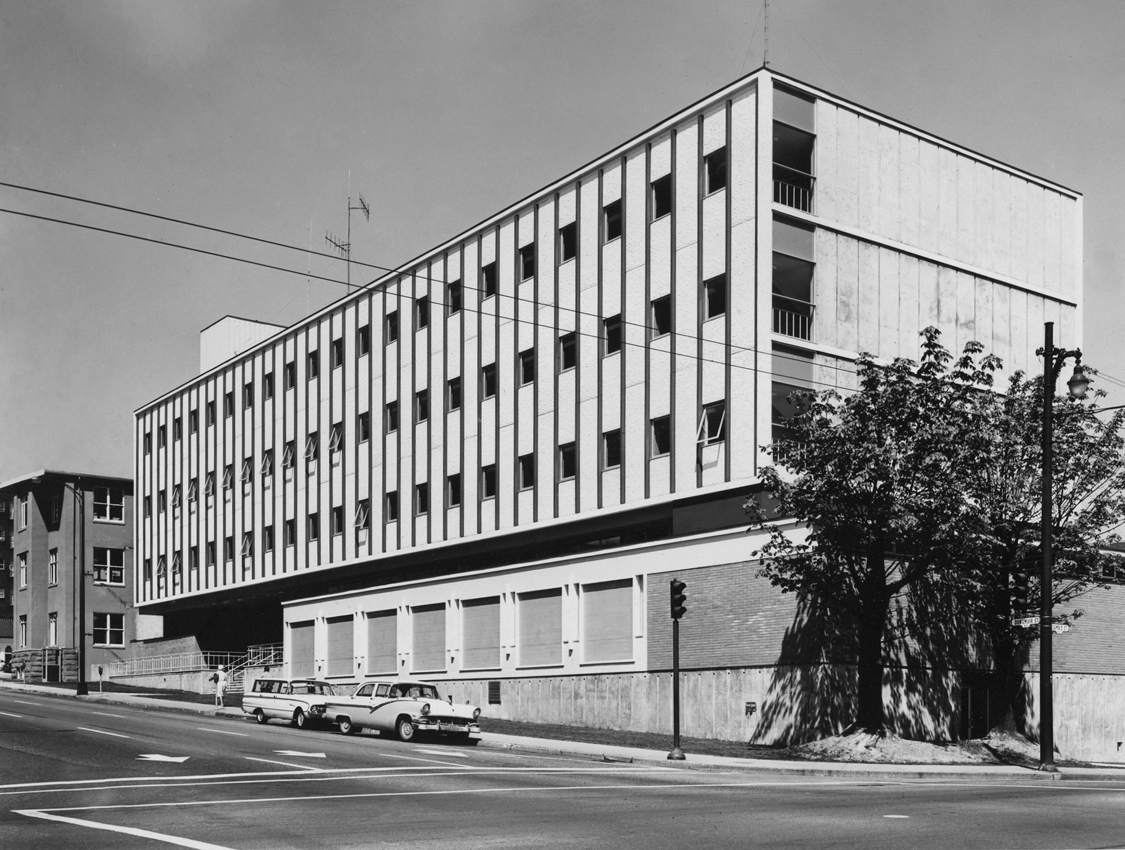The Early Years of the Vancouver Vocational Institute – BUILDINGS AND PROGRAMS

THE EARLY YEARS OF THE VANCOUVER VOCATIONAL INSTITUTE
The following passages are taken from PART IV of a history of the Vancouver Vocational Institute written by Hans W. Rerup, former Principal of the Vancouver Vocational Institute and published in 1993. The photos are from the Vancouver School Board Photo Archives.
(Summary: The reasons why the Vancouver Vocational Institute was established, the role of the Vancouver School Board in creating and managing the Vancouver Vocational Institute. The financing, organization, goals, and instructional programs of the Vancouver Vocational Institute. The challenges faced by the Vancouver Vocational Institute.)
_____________________________________________________________________________________________________________
40 YEARS HISTORY
VANCOUVER VOCATIONAL INSTITUTE
1949 – 1989
Preface: The content of this work has been collected from many people and sources. The writing has taken a number of years with repeated interruptions for more important activities. Thanks go out to all those people who have in some way contributed to the final completion of this history. Much more could have been written about the functioning of the programs, the advisory committees, the committee organizations, and the financial problems. However, it is doubtful that such content would have been interesting from an historical perspective. May the reader at least with this attempt gain some insight into this former institution.
Hans W. Rerup, February 1993
The Buildings of the Vancouver Vocational Institute
Date: 1949 Looking south towards Block 37. In the foreground, the newly completed Vancouver Vocational Institute building. In the background, at centre, the Vancouver School of Art. On the far right, the Vancouver School Board building.
The seeds for the Vancouver Vocational Institute were sown during the Second World War. During the war many crash training programs had to be mounted to provide a skilled workforce in support of the war effort. With the men off to war, women in large numbers were trained successfully for jobs in the new industries of aviation and shipbuilding in the Vancouver area.
Many of the men, who went off to war in 1939, had come directly from long periods of unemployment during the depression. Following the end of the war the large number of returning veterans required training for peace time activities. In addition, greater numbers of high school graduates than ever before were requiring specific job oriented pre-employment training. There was a scarcity of traditional apprenticeship training places in the trades, which had served the need for trained tradesmen before. Therefore, it was decided to create a new type of training called re-employment training. This was supposed to speed up the transition from unemployment and war type activity to peace time regular jobs without having to go through the normal three to four year apprenticeship period.
It was in this sphere of need that the Vancouver Vocational Institute became a reality. The Vancouver School Board of Trustees took leadership role in attempting to fill a void in the training needs of its citizens. Over the years the Vancouver School Board had already shown an avant-garde leadership role in education by the establishment of its Adult Education Night School programs. These programs had start in 1906 at the King Edward High School. Since the start of that program, many trades courses were offered there on a part-time basis.
The Vancouver Technical High School on east Broadway further attested to the efforts of the Vancouver School Board to broaden educational opportunities in the City of Vancouver for its citizens. For many years, long before newer institutions took over the leadership role in technical vocational education, graduates from Vancouver Technical High School held key positions in business and industry. Former teachers at the Vancouver Technical High School became the administrators and innovators at the new Vancouver Vocational Institute.
In 1947 Mr Dean H. Goard was appointed as the Principal of the Vancouver Vocational Institute. Together with others, he toured the North American continent to see what was being one in technical education for adults. Mr. Goard visited twenty-nine training institutions in seventeen cities throughout the United States in order to gain the best insight into how such a new institution should be constructed and operated. Using these ideas, he established Program (or Trade) Advisory Committees in each area of programming intended to be included in the Vancouver Vocational Institute. These committees assisted in the development of plans for shops, laboratories, program outlines, and training schedules.
Because of the very high cost of the building and its large equipment content, an intensive utilization of the facility was planned from the first day. It was intended that the facility be utilized fully in the evening for part-time apprenticeship and vocational upgrade courses in addition to the full-time day programs. History would show that it would become one of the most intensively utilized post-secondary institutions in the country.
The financing for the construction of the Vancouver Vocational Institute came from the federal, provincial and local governments. The federal interests were directed towards financially assisting war veterans, who were to receive special consideration in the new institute. The federal Department on Indian Affairs supported substantial numbers of native indians into training programs at the Vancouver Vocational Institute. The federal government sent numerous RCMP constables to the institution from across Canada for technical training in electronics and radio communications.
From a provincial perspective, a number of existing training efforts were moved from dispersed locations and from different public agencies and were merge under the roof of the new Vancouver Vocational Institute These programs would include, for example, the Power Sewing program commenced in 1936 in the City of Vancouver, and the Practical Nursing Program from the Vancouver General Hospital. The local interests were focused on providing an efficient institutionalized alternative to the customary apprenticeship in the trades area. In 1949 the first principal, Mr. Goard, stated that the Vancouver Vocational Institute would be a school that would offer “a trades atmosphere rather than a scholastic one”. The training was to include extensive hands-on activities for the student in order to reflect, as closely as possible, real job situations.
Vancouver Technical High School as it looked in the 1930s.
The embryonic stages of the Vancouver Vocational Institute took place at the Vancouver Technical High School and drew on the expertise and resources of the technical teachers available there. In 1948, the first receiver, Mr. Ken Jeavs was hired for the Vancouver Vocational Institute and temporarily located at the Vancouver Technical School. He was to receive and store the multitude of technical ship, laboratory, and classroom equipment required for the programs at the Vancouver Vocational Institute.
The architectural and construction plans were developed by the architectural firm of Sharp, Thomson, Berwick and Pratt together with the architect of the Vancouver School Board, Mr. E.C. King. The construction contract was awarded to Commonwealth Construction Co. Ltd., and the work was carried out during 1948 and early 1949 on the site of the former Central School.
1948: Central School, the first masonry elementary school built in Vancouver is demolished to make way for construction of the first Vancouver Vocational Institute building.
The plans called for a $2,000,000 construction of a facility which was to hold a maximum of 600 students in possibly 23 classes or different programs. Classes in all trades areas were to hold twelve students. Later the class sizes would be pushed upward by the demand for training as space permitted.
The formal name of the Vancouver Vocational Institute was determined by the Vancouver School Board at its 1949 February meeting.
In August of 1949 Mr. S. V. Clark joined the administrative staff as Vice Principal at the Vancouver Vocational Institute. He arrived from the Vancouver Technical High School just prior to commencement of instruction taking place at the new institution.
Though the Vancouver Vocational Institute did not officially open before November 1949, students had been on site before September. The first classes, in the name of the Vancouver Vocational Institute, commenced even before that time in other locations in the city. For example, the first class of Licensed Practical Nurses started in January of 1948, and the first graduates of that program received their pins in December of that year.
1949: Two photos showing the construction of the first Vancouver Vocational Institute building.
The official opening of the Vancouver Vocational Institute was on the eighth day of November of 1949. It was attended by dignitaries from all levels of government and industry. This supported the claims made at the time that the Vancouver Vocational Institute was to provide the best and most advanced in technical education in North America. Among the many who attended the opening ceremonies were: the Honourable Humphrey Mitchell, Minister of Labour for Canada; the Premier, the Honourable Byron Johnson; the Honourable W.T. Straithe, K.C., Minister of Education of British Columbia; and members of the Vancouver Board of School Trustees, with Dr. J.D. Ross as Chairman.
Three photos of the first Vancouver Vocational Institute building, which opened in 1949.
The Vancouver Vocational Institute was a success from the beginning. In general, the training programs, which had been given space in the facility, had been planned each for a single class of students at any given time. The training programs quickly faced growing waitlists of applicants. Two to three classes were squeezed into instructional spaces designed for only one class. This squeezing of more students into of space than it was designed for became the continuing saga and theme over the next forty years of operation for the Vancouver Vocational Institute.
Prompted by the disparity in the treatment of funding for adult vocational training in the province of British Columbia, the Vancouver School Board of Trustees made in 1957 a major presentation to the Minister of Education on behalf of the Vancouver Vocational Institute. The Trustees pointed out that the Province fully funded the Nanaimo Vocational School and was prepared to do the same for the proposed vocational school in Burnaby and Prince George, yet the Vancouver Vocational Institute had been serving the whole province at the expense of the ratepayers of the City of Vancouver. The daily operation of the institute was paid for out of the $10 per month tuition paid by the fee-paying students and through the sponsorship of other students by various federal and provincial agencies. By 1958, overflow classes had to be mounted in many off-campus locations. In that year, for example, twenty-six classes were offered in the Poultry and Livestock Buildings at the Pacific National Exhibition Park. In the same year, these classes became the core programs of the British Columbia Vocational School in Burnaby directly under the Department of Education of the provincial government.
All available space on campus was used or converted to instructional use. The gymnasium was sub-divided into two levels with cafeteria space on the upper level and instructional space on the lower level. The wooden gymnasium floor was finally removed in 1981 during another renovation.
Soon the training programs at the Vancouver Vocational Institute were overflowing the capacity of the space on campus again. In 1959 ninety classes had to be move onto the IBEW Hall, the old Aberdeen School in downtown Vancouver, and other schools in the City.
In September of 1961, Vancouver Sun reported that planning was underway for an expansion of the Vancouver Vocational Institute. At about the same time the federal government made funds available to all provinces for the expansion or new construction of technical training facilities. These funds were granted for projects which were to be built on a shared basis, with the federal government paying 75% of the cost and the rest being financed by the provincial governments or other local sources…
While the Vancouver Vocational Institute was experiencing growth problems, so was the Vancouver School of Art. In 1952, the Vancouver School of Art had vacated the old Vancouver High School and taken over the old Vancouver School Board office building on the southwest corner of the city block. The old Vancouver High School was demolished in 1954 and replaced with a green lawn.
1961: Four views of a model showing how the Vancouver Vocational Institute would look following new construction to expand the facility.
The proposed new $2 million expansion on the site was designed to accommodate the space needs of both the Vancouver Vocational Institute and the Vancouver School of Art both creatures of the Vancouver School Board. New facilities were specifically constructed for Graphic Arts, Dental Assisting, Baking, Electronics, Telecommunication, and Medical Office Assistant programs. Funding was provided for some underground parking to be used by the federal government’s other operations in the city, such as the Post Office, for a ten year period. A major expansion of the Hairdressing, Diesel Engineering, Auto Body, and Welding programs was included in the plans. By November 1961 A.R. Grimwood Ltd. was awarded the construction contract with a scheduled completion date of March 1963.
1962: View of the construction site. At far right, the south corner of the Vancouver School of Art. Behind, the Vancouver Central Post Office building.
On April 29th, 1964 the expansion was completed and the official opening took place following a gala dinner at the Vancouver Vocational Institute. On this occasion, the first issue of the “Vancouver Vocational Institute Times Recorder” was printed by the Graphics Arts Department.
The list of attenders at the official opening reads as a who is who in education and politics over the last thirty years. The expansion was opened by the Honourable Minister of Education, Mr. Leslie R. Petersen. In attendance were: The Honourable Arthur Laing, Minister of Northern Affairs and Natural Resources; R. Ross Ford, Director of the Technical and Vocational Branch, Department of Labour, Government of Canada; Dr. J.F.K. English, Deputy Minister and Superintendent of Education, Province of British Columbia; and Mr. W.G. Rathie, His worship, Mayor of the City of Vancouver. Also in attendance at the opening, as a trustee of the Vancouver School Board, was Mr. John Henderson, called by many “the father of the Vancouver Vocational Institute” and who was active for many years in the affairs of the institute.
Five photos showing new facilities added to the Vancouver Vocational Institute during reconstruction of the facility, which was completed in early 1963.
In 1962, the Vancouver School Board created a new venture in adult education in Canada by creating the King Edward Senior Matriculation and Education Centre on the premises of the historic King Edward High School. In 1965, that Centre, along with the Adult Education Division of the Vancouver School Board, the Vancouver School of Art, and the Vancouver Vocational Institute became Vancouver City College. Notwithstanding this forced merger, it would take a number of years before that melding would have a significant impact on the operation of the Vancouver Vocational Institute. The full integration of the Vancouver Vocational Institute into the College happened in December 1970.
By 1967 Vancouver Vocational Institute was in trouble again. Some 5200 students were enrolled. By 1967 fifteen classes were again operating at the Pacific National Exhibition Park. The impact of the new federal legislation in support of manpower training and the training of the unemployed and under-educated had filled the campus to the roof once again.
In March 1967, the Vancouver School Board planned to expand the Vancouver Vocational Institute to the block east of the campus. The City of Vancouver placed a reserve on this block for the proposed expansion. Mr. Dean H. Goard, the former Principal of the Vancouver Vocational Institute and now Director of Adult Education for the Vancouver School Board, undertook a major needs analysis of both the Vancouver Vocational Institute and the Vancouver School of Art. The expansion proposal was in the order of $4.8 million. In the meantime, the Vancouver School of Art continued to rent space on the ground of the Pacific National Exhibition Park and in Gastown. However, the expansion plans came to nought.
In 1968, many classes of the Vancouver Vocational Institute were conducted in temporary and substandard accommodation at Point Grey School, Tupper Secondary School, the Vancouver Technical School and the King Edward Centre.
In the 1968/69 school year the Vancouver Vocational Institute was delivering training for some 2326 full-time equivalent students with 113 instructors, as compared to 1,650 full-time equivalent students with 72 instructors in the 1963/64 school year. The enrolment had increased an average of 50% in those years. Drs. Bert Wales and Tom Gilligan wrote brief after brief to the Minister about the on-going over-crowding and long waiting lists at the Vancouver Vocational Institute.
The very substantial increase in enrollment was mainly due to the 42 % of the students who now were sponsored by the Canada Employment and Immigration Commission (CEIO) or “Manpower”. On campus all full-time second shifts in all programs on campus were mainly classes of federally sponsored students. This original separation of “Manpower” students from regular fee-paying students was quickly abandoned by the Vancouver Vocational Institute…
In 1970, the King Edward Senior Matriculation and Adult Education Centre moved to the new campus at Langara on 40th Avenue. This vacated space allowed for some relief of the crowding at the Vancouver Vocational Institute in that the Adult Basic Education, Basic Training and Skill
Development, and English-as-a-Second Language Programs were moved into the vacated old King Edward High School buildings. These programs were then designated as the Special Programs Division of Vancouver City College.
(On March 11, 1974, a BC Government Order-in-Council changed Vancouver City College’s name to Vancouver Community College and severed all remaining ties to the Vancouver School Board. The VCC was now a separate and independent entity.)













